#richard shaver
Explore tagged Tumblr posts
Text
Midnight Pals: Shaver Mystery
Ray Palmer: listen midnight society i got a crazy story you gotta hear! Palmer: i found this guy, Richard shaver Palmer: he's got a story you wouldn't believe Palmer: but every word of it is the god's honest truth! Palmer: if i'm lying, may lightening strike me down!
Palmer: go ahead Richard, tell them what you told me Richard Shaver: there's an underground civilization of lemurians Shaver: living in tunnels under the comet ping pong pizza restaurant Palmer: big if true!
Shaver: after the lemurians abandoned these tunnels, people moved in Shaver: but they tried using the lemurians' abandoned death rays Shaver: but they didn't realize that if you don't change the filters on the death rays, it'll turn them into deros Barker: oh yeah you gotta change the filters on those death rays Barker: i mean who doesn't do that Poe: clive you really shouldn't make fun of him Poe: i don't think that's sporting
Shaver: anyway by misusing the death rays, it turned them all into deros Shaver: which stands for detrimental energy robot Barker: oh yeah of course it does Barker: that would have been my guess Poe: clive
Shaver: the deros can use their death rays to spy on your thoughts and control your mind Poe: ray i don't think this man is well Poe: i think you might be exploiting him Palmer: what? never! Palmer: he's fit as a fiddle! Shaver: also every day has within it four simultaneously occurring days
Palmer: wow! can you believe that's all true? Poe: ray, i don't think that's true Palmer: not true? look here buddy Palmer: its printed on the pages of Amazing Stories Palmer: all the news thats fit to print!
August Derleth: we're pals aren't we howard? bestest pals? HP Lovecraft: [sweats] Derleth: august and howard, that's what people call us! Derleth: cuz they're so used to seeing us together Derleth: we're practically inseperable!
Barker: boy you two really are thick as thieves huh Lovecraft: [sweats] Barker: august and howard huh Derleth: you can call us augie and Howie Barker: i'm not gonna do that
Palmer: in fact, i have a little something right here Palmer: linking the shaver mystery to the Cthulhu mythos Derleth: i'll kill you Derleth: i swear to god no one will ever find your body Palmer: Derleth: i will obliterate you
Palmer: whoa whoa whoa just take it easy there pal Palmer: i'm just tryin' to make a buck here, can't blame a guy for makin' a livin' can ya? Derleth: i will murder you Derleth: i will murder you dead Palmer: [sweats] ha ha whoa by is it getting hot in here? Palmer: [tugging collar] is anyone else getting hot in here?
Palmer: i'm just saying people love thinking spooky stuff is real Palmer: maybe lovecraft thought Cthulhu was real Palmer: we could make a lot more money if he did Derleth: hey mary let me see your knife Shelley: here ya go
Poe: mary don't give him your knife Shelley: it's my knife edgar i can do what i want Poe: why do you want to see Mary's knife Derleth: no reason i just want to see it Shelley: good enough for me
Palmer: you know what, i'm just gonna see myself out Poe: mary don't give him your knife Derleth: GIVE ME THE KNIFE!
#midnight pals#the midnight society#midnight society#clive barker#edgar allan poe#hp lovecraft#august derleth#mary shelley#ray palmer#richard shaver
76 notes
·
View notes
Text
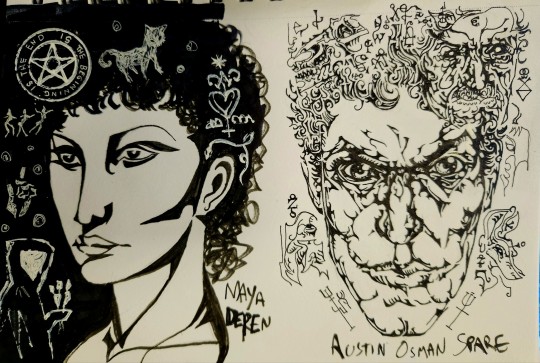
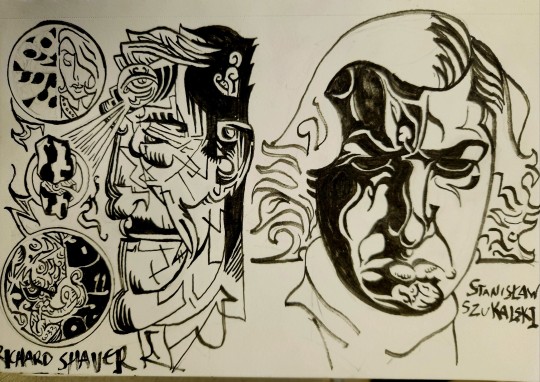

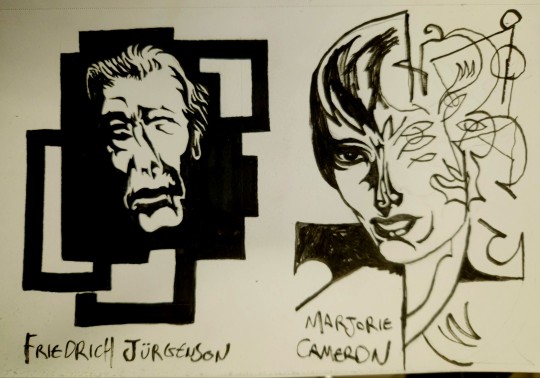
Various writers and artists involved with the occult and esoteric
#klyart#occult#georges bataille#maya deren#austin osman spare#Heinrich Jorgensen#marjorie cameron#richard shaver#stanisław szukalski#ernst fuchs
185 notes
·
View notes
Text

Dick Shaver solicits pre-orders for a hardcover reprint of "I Remember Lemuria!" and for some reason chooses to do so while smoking a cigarette and draping a towel over his head.
327 notes
·
View notes
Text

"The prince found himself looking at a horned woman of a very strange beauty, and she was smiling"
Rod Ruth (1912-1987) - Illustration for Richard S. Shaver's 'The Princess and Her pig'
(Fantastic Adventures Vol.9 #2, March 1947)
#rod ruth#the princess and her pig#richard s. shaver#fantastic adventures magazine#horror art#fantasy art#pulp art#illustration#story illustration
1K notes
·
View notes
Text

Vintage Pulp - Other Worlds (Nov1949)
Art by Richard S. Shaver
Clark Magazines
#Magazines#Other Worlds#Science Fiction#Fantasy#Pulp#Richard S Shaver#Clark Magazines#Vintage#Art#Lemuria#1949#1940s#40s
93 notes
·
View notes
Text
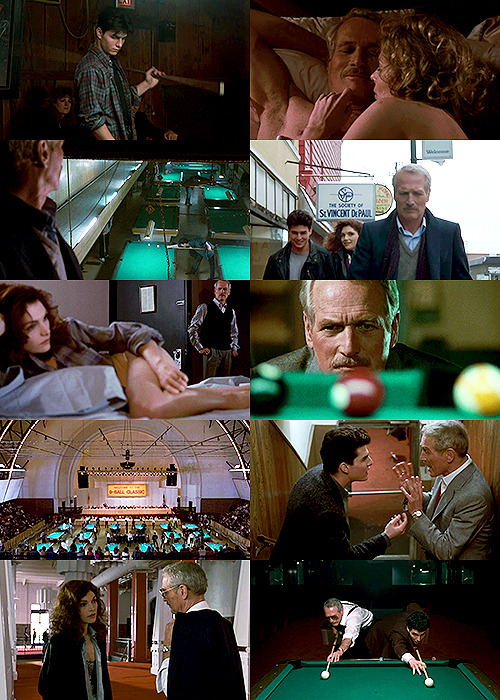
The Color of Money (1986). Fast Eddie Felson teaches a cocky but immensely talented protégé the ropes of pool hustling, which in turn inspires him to make an unlikely comeback.
Paul Newman truly is That Actor - boundless charisma and an undeniable screen presence - he always delivers, and does so again here. He actually pairs really well both with Tom Cruise, who's playing the ingenue here in a kinda fun role reversal, and Mary Elizabeth Mastrantonio, who plays a woman hungry for a life bigger than the one she's ended up with. It's got some great and tense action sequences too, and is just overall a pretty fun sports film. 8/10.
#the color of money#1986#Oscars 59#Nom: Actor#Won: Actor#Nom: Supporting Actress#Nom: Adapted Screenplay#Nom: Art Direction#Martin Scorsese#walter tevis#richard price#tom cruise#paul newman#Mary Elizabeth Mastrantonio#helen shaver#John Turturro#bill cobbs#sports#billards#mentor-mentee#8/10
17 notes
·
View notes
Text
youtube
Guerra nas Estrelas, Contatos Imediatos e Christopher Lee: Invasão dos Extraterrestres!
#Starship Invasions#chistopher lee#Edward Hunt#sci fi#Project Genocide#ets#aliens#Robert Vaughn#victoria johnson#tiiu leek#worst movies#trash movies#Daniel Pilon#Helen Shaver#Henry Ramer#Richard Fitzpatrick#Sean McCann#Jonathan Welsh#kate parr#Kurt Schiegl#Holly Dale#Youtube
2 notes
·
View notes
Video
Amazing Stories / March 1949 (Vol. 23 #3) by Michael Studt Via Flickr: Amazing Stories / Heft-Reihe - Leroy Yerxa [Lee Francis] / The Chemical Vampire - Chester S. Geier and Taylor Victor Shaver / The Strange Disappearance of Guy Sylvester - Chester S. Geier [Guy Archette] / The Lost Power - Leroy Yerxa / The Strange Tea of Ting Sun Fu - Henry Bott [Charles Recour] / The Swordsman of Pira cover: Edmond Swiatek (Cover illustrates "The Chemical Vampire") Editor: Raymond A. Palmer Ziff-Davis Publishing Company (Chicago/Illinois) März 1949 ex libris MTP en.wikipedia.org/wiki/Amazing_Stories
#science fiction#sf#Sci-Fi#Zukunftsromane#pulps#Ziff-Davis#Amazing Stories#Wissenschaftler#Labor#Retorte#Chemie#Lee Francis#Frances Yerxa#Lawrence Trilby#Richard Casey#Carter T. Wainwright#Rog Phillips#Chester Merkle#Raymond A. Palmer#Leroy Yerxa#The Chemical Vampire#Chester S. Geier#Guy Archette#The Lost Power#Taylor Victor Shaver#The Strange Disappearance of Guy Sylvester#The Strange Tea of Ting Sun Fu#Henry Bott#Charles Recour#The Swordsman of Pira
0 notes
Text


Shaver Mystery Magazine 1947
Small magazine dedicated to the further study of the hidden truths as presented in the fact-fiction stories by Richard S. Shaver, once published in Amazing Stories Magazine
136 notes
·
View notes
Text

Sir Kenneth Grange
A giant of 20th-century design whose products – from food mixers to lamps and trains – became staples of British life
Kenneth Grange, who has died aged 95, was the leading British product designer of the second half of the 20th century. Even if unaware of his name, most people in Britain are familiar with his output: the Kenwood Chef food mixer, the Kodak Instamatic camera, the Ronson Rio hairdryer, the Morphy Richards iron. These everyday objects are part of all our histories. Grange was also responsible for the restyling of the InterCity 125 high-speed train and the 1997 TX1 version of the London taxi.
He was a tall, handsome, ebullient man, a joker with that element of inner moral purpose often found in the designers of his postwar generation. He grew up imbued with a determination to make the world a better place visually, his emphasis always on functional efficiency. Grange was a master at reassessing usage, but he also viewed design in terms of sheer enjoyment. He wanted us to share in the surprising grace of the experience as the 125 train comes hurtling down the track.
When he set up his own design consultancy in 1956, Grange was one of just a handful of designers operating in the world of what were then quaintly called consumer goods. Many of his early commissions came via the Council of Industrial Design (now the Design Council), a governmental body set up with the remit of improving national design standards. Grange’s commission to design Britain’s first parking meter, the Venner, introduced in 1958, came via the council. So too did his introduction to Kenneth Wood, proprietor of the firm in Woking whose domestic products were marketed as Kenwood. Grange’s clean-lined and user-friendly Kenwood Chef food mixer became a housewives’ status symbol of its time.
Like his near contemporary Vidal Sassoon, Grange came from a non-artistic background and had a similarly innate sense of visual style. Both men were quintessentially 1960s talents, Sassoon with his geometric haircuts, Grange with a succession of urbane modern products for a new, self-consciously fashionable age. He became a prime designer for the growing market in “portable accessories”: pens for Parker, cigarette lighters for Ronson, the melamine and smoked perspex Milward Courier shaver which, in 1963, won the Duke of Edinburgh’s prize for elegant design (now known as the Prince Philip Designers prize). Did Prince Philip himself use it? Grange insisted that he did.
In 1972 Grange joined four of the rising stars of his profession – Alan Fletcher, Colin Forbes, Theo Crosby and Mervyn Kurlansky – in founding the ultra-modern design group Pentagram. This was a multidisciplinary consultancy described by Grange as “a one-stop shop” providing specialist services in graphic design and advertising, architecture and – Grange’s own area – product design.
Pentagram became the bee’s knees of design consultancies: ambitious, professional, intelligent and jaunty. It attracted loyal clients, including Reuters, for whom Grange designed the Reuters monitor, a state-of-the-art computer terminal and keyboard, superbly well engineered in heavy silver aluminium sheet.
Through the 70s Grange was occupied with the most high profile of his design commissions: the aerodynamics, interior layout and exterior shaping of the nose cone of British Rail’s High Speed Train (HST). The InterCity 125 was a key element in BR’s strategy to woo passengers away from cars and planes and back on to the trains. However the first HST prototype they came up with was, in Grange’s opinion, “a lumpish, brutish thing”.
He realised he could only improve the appearance by first tackling the aerodynamics. On his own initiative (and at his own expense) he spent a week at night working with a consultant engineer at Imperial College London, where there was a wind tunnel. In the course of these experiments they developed a number of new ideas, getting rid of the buffers, hiding the couplings in the underside of the nose cone, and giving the train a more futuristic look.
It was launched in 1976 with its radical, dynamically angled nose design. Grange was always careful to give credit to the expertise of the engineers he worked with. All the same, it was his major triumph and a lasting symbol of the best of mid-20th-century British design. The HST – still in use today on selected passenger services after almost 50 years – transformed the public experience of travelling by train.
He was born in east London, the son of Hilda (nee Long), a machinist, and Harry Grange, an East End policeman. Kenneth was brought up in what he once vividly described as “a bacon-and-eggs kind of house”, respectably furnished with a three-piece suite and flowery curtains, the dominant colour being brown. Nevertheless his parents supported his chosen career in what was then termed “commercial art”. During the second world war, the family had moved to Wembley in north London, and Kenneth won a scholarship to Willesden School of Art and Crafts where, from the age of 14, he studied drawing and lettering.
These basic skills gave him the entree to a succession of architects’ offices: Arcon; Bronek Katz and R Vaughan; Gordon and Ursula Bowyer; and, from 1952, the remarkably versatile architect and industrial designer Jack Howe – all of these were modernists and prime movers in the postwar campaign to rebuild Britain using newly available materials and techniques.
Grange took part in the 1951 Festival of Britain, working alongside Gordon and Ursula Bowyer on the Sports Pavilion for the South Bank exhibition. For so many of Grange’s generation of designers – including Sir Terence Conran and my husband, David Mellor – the festival would be a lasting inspiration. As Grange later recollected: “You couldn’t walk a step without seeing something unlikely – the cigar-shaped Skylon, the huge Dome of Discovery, extraordinary metal sculptures, waterfalls that twisted and turned. Nothing was like anything I had ever seen before.”
Where much of British design was still craft-based, dominated by ideas that went back to William Morris, Grange felt the fascination of machine production. He was excited by the sleek designs based on new technology beginning to infiltrate Britain from the US, describing the moulded plastic Eames chair for example as “a rocket ship exploding into our narrow world”. I remember being impressed on my first visit to his house in Hampstead, north London, to find him the possessor of not just one Eames lounge chair but three.
Grange’s natural resilience stood him in good stead through the 70s and 80s, those lean years for designers when British manufacturing lost its way and, as he described it, “unbridled accountancy became the new dynamic in British industry”. He was glad of foreign clients, especially enjoying working in Japan where the innate Japanese awareness of design delighted him. An especially successful commission was a sewing machine designed for the Maruzen Sewing Machine Co in Osaka, to be marketed in Europe. On trips to Japan he started what became a considerable collection of beautiful wooden geisha combs.
Pentagram itself was flourishing, moving in 1984 from Paddington to larger and more stylish premises in a renovated dairy in Notting Hill. At this period it employed more than 80 designers and assistants in different disciplines, and the communal dining room became an ever-welcoming talking shop, a gathering point for London’s design world of the time. I remember some marvellous parties at Pentagram, including the celebration of Grange’s marriage in 1984 to Apryl Swift.
For Grange himself the 1980s brought increasing public recognition. In 1983 a solo exhibition of his work was held at the Boilerhouse at the Victoria and Albert Museum in London.
At this point he was already being lauded as Britain’s most successful product designer. He was made CBE in 1984, and knighted in 2013. In 1985 he received an honorary doctorate from the Royal College of Art and in 1986 became master of the elite group of Royal Designers for Industry. Success never spoilt him. He had a streak of self-denigrating humour and retained a kind of boyish innocence, as if he could hardly believe his good luck.
The sheer challenge of the job had always been his driving force. After his retirement from Pentagram in 1997, after 25 years as a partner, he and Apryl embarked on a project of their own, converting an ancient stone-built barn in the remote countryside near Coryton in Devon into a spectacular modern home with a spiral staircase of highly ingenious modular construction. Completion took five years; Grange commuted weekly between London and Devon, travelling on his familiar High Speed Train.
In 2011 the Design Museum held a retrospective, Kenneth Grange: Making Britain Modern. He continued to design into his 80s. Late commissions included the perfect men’s shirt for the fashion designer Margaret Howell; an updated range of classic lights – the Type 3, Type 75 and, in his 90th year, the Type 80 – for Anglepoise, for whom he had been made design director in 2003; and a really comfortable collection of chairs for elderly people. General levels of design for the aged population made him angry. “Where is the decent modernist care home?” he would ask.
Typical of Grange’s zany 60s humour was his design of a man-shaped timber bookcase that converted to a coffin, the ultimate exercise in recycling. “If I ever pop my clogs, it’s books out and me in, with the lid fixed, up to the great client in the sky.”
Two earlier marriages ended in divorce. Apryl survives him.
🔔 Kenneth Henry Grange, designer, born 17 July 1929; died 21 July 2024
Daily inspiration. Discover more photos at Just for Books…?
10 notes
·
View notes
Text
Midnight Pals: The Shaver Mystery
Richard Sharpe Shaver: Submitted for the approval of the Midnight Society, I call this the tale of the underground monster people that can control us with mind rays Stephen King: wow, that sure sounds like an amazing story! Shaver: yes Shaver: yes it is
Shaver: did you know that there’s a secret cabal of underground monsters who kidnap people for sexual torture and cannibalism? Koontz: gosh! That’s not real tho right? Koontz: it’s just a story right? King: yes dean it’s just a story Shaver: don’t tell him that Shaver: this is real
King: c'mon richard you're just having a laugh, it's all just a story Shaver: this is real Shaver: there's a secret cabal of underground monsters who kidnap people for sexual torture and cannibalism Shaver: and that's not all Shaver: wait until you hear what they’re doing to the soil
Dan Simmons: a secret cabal of underground monsters who kidnap people for sexual torture and cannibalism? Shaver: that's right Simmons: damn you could base a whole political worldview on that! Simmons: Simmons: are they in league with the queers and the muslims? Shaver: I don’t know what that is but probably Simmons: I knew it!
Simmons: these underground cannibals sound p legit to me King: dan i don't think they're real Simmons: oh I see, so you think that when i say "underground cannibals" that's, like, code for greta thunberg and that when i say we must stop the underground cannibals that's a veiled threat calling for the murder of greta thunberg and the public desecration of her carcass as a warning to all blue haired millenial they/thems? King: King: well i do now Simmons: wow steve Simmons: i think that says a lot more about you than me
Simmons: you know what these underground cannibals who prey on white women are like? Simmons: they're like "urban" "thugs" wearing "hoodies" Lovecraft: Simmons: and "baggy pants" Lovecraft: Simmons: if you know what i mean Lovecraft:
Simmons: i'm sorry, are these dog whistles too subtle? Simmons: i mean Simmons: Simmons: italians Lovecraft: [immediately starts sweating]
Simmons: so the underground cannibals are in league with george soros Simmons: and that caravan of latin refugees Simmons: that we were all so scared of about 3 years ago Simmons: and then just forgot about when it strangely failed to materialize Simmons: I can’t believe AM radio got that one wrong!
#midnight pals#the midnight society#midnight society#richard sharpe shaver#stephen king#dean koontz#hp lovecraft#dan simmons
84 notes
·
View notes
Note
I randomly googled Shaver Mystery and after reading Richard Sharpe Shaver's wiki I just can't stop thinking about how people with schizophrenia might have had a huge impact on scifi. Like take telepathy. A person hears voices and logically assumes they are hearing other people's thoughts. Richard thought he was telepathically picking up torture sessions from evil subterranean people. Like any person is capable of radical creativity but there must be something to schizophrenic peoples who are trying to make sense of disordered thinking. Idk am I out of line in saying that? I don't mean it in a derogatory way. Maybe they believe their own fantastical stories maybe they don't. As a person who grew up in a mentally ill religious family I also liken it to weird lore in the Bible. There's an all powerful man in the sky who can hear your thoughts. Sometimes believing in God made my mental illness better sometimes it made it worse. I imagine writing scifi is similar. You could get deeper in your delusions or you could feel validated in your writing.
That’s not out of line at all. The human mind is endlessly fascinating
It appears rather evident that the esteemed Richard Shaver did indeed suffer from some sort of paranoid schizophrenia. According to his friends and colleagues, Shaver truly believed that his life was being controlled by unseen forces residing in deep, subterranean caverns. The voices that emanated from this underground realm were sometimes kind and benevolent, other times cruel and vicious. Both voices spoke to him regularly, constantly assailing with all manner of ideas, assumptions and commentary.
Shaver coped with these intrusive verbal hallucinations by creating a rich and textured mythology around it all. The benevolent voices came from the righteous Tero; whereas the malicious voices came from the villainous Dero. These two races of beings lived in the center of the earth and were the descendants of extraterrestrial travelers.
The stories that Shaver wrote about the Tero and the Dero were super vibrant and rich. They were fantastical, often absurd, yet told in such an ernest, convincing and multifaceted fashion that readers were just whisked away. Fans couldn’t get enough of these wild tales his contributions to ‘Amazing Stories’ made it a hugely successful pulp periodical.
Shaver’s ability to seize his psychological difficulty and use it for the benefit of his craft is similar to the mathematician John Nash, author Zelda Fitzgerald, jazz musician Buddy Bolden and painter Vincent Van Gogh. This is not to suggest that genius is derived through psychological malady but rather there can be instances were extreme adversity can contributed to the brining about of something unexpectedly awesome.
8 notes
·
View notes
Text
Doctor! Doctor!
When it comes to parts for women in sci-fi, I may be starting to pick up on a pattern here...

Kyra Zagorsky as Dr Julia Walker in Helix

Gates McFadden as Dr Beverly Crusher in Star Trek: The Next Generation
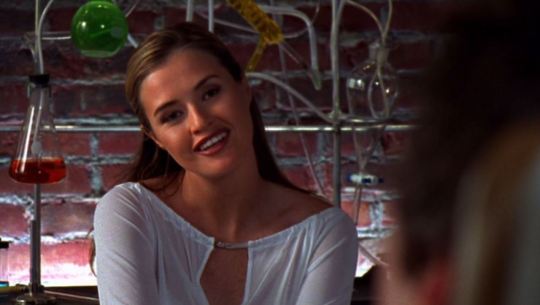
Shannon Kenny as Dr Claire Keeply in The Invisible Man (2000)

Kari Matchett as Dr Mariel Underlay in Invasion (2005)

Kim Cattrall as Dr Sheila Moran in Invasion (1997)

Deanna Russo as Dr Sarah Graiman in Knight Rider (2008)

Carla Gugino as Dr Molly Anne Caffrey in Threshold

Maria del Mar, Alexandra Wilson, Gay Thomas Wilson as, respectively, Dr Haylen Breslauer, Dr Dru Breslauer and Dr Rema Cook in Mercy Point

Fiona Gaunt as Dr Helen Smith in Moonbase 3

Lee Meriwether as Dr Ann MacGregor in The Time Tunnel

Yvonne Craig as Dr Marjorie Bolan in Mars Needs Women

Diana Muldaur as Dr Katherine Pulaski in Star Trek: The Next Generation

Susannah Harker as Dr Angela Marsh in Ultraviolet

Lynda Mason Green as Dr Suzanne McCullough in War of the Worlds (1988)

Lois Chiles as Dr Holly Goodhead in Moonraker

Jess Bush and Dr Christine Chapel in Star Trek: Strange New Worlds

Alison Pill as Dr Agnes Jurati in Star Trek: Picard

Carmen du Sautoy as Dr Gentian Foster in Astronauts

Debra Messing as Dr Sloan Parker in Prey
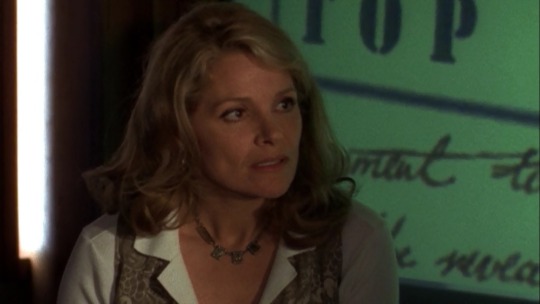
Helen Shaver as Dr Rachel Corrigan in Poltergeist: The Legacy

Denise Richards as Dr Christmas Jones in The World is Not Enough

Hermione Norris as Dr Stella Isen in The Outcasts
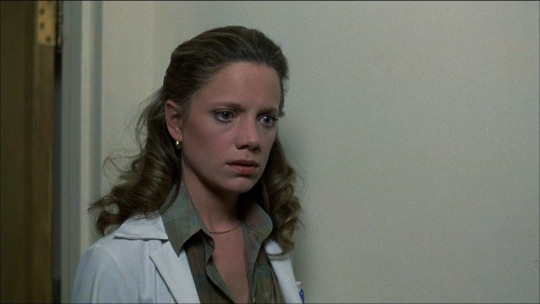
Gretchen Corbett as Dr Maggie Sheridan in Jaws of Satan
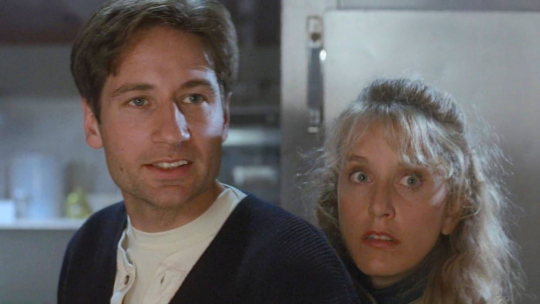
Felicity Huffman as Dr Nancy Da Silva The X-Files 'Ice'

Louise Jameson as Dr Anne Reynolds in The Omega Factor

Vivian Wu as Dr Lu Wang in Away

Christina Wolf as Dr Cat Brandice in The Ark

Yvette Mimiuex as Dr Kate McCrae in The Black Hole

Saffron Burrows as Dr Susan McCallister in Deep Blue Sue
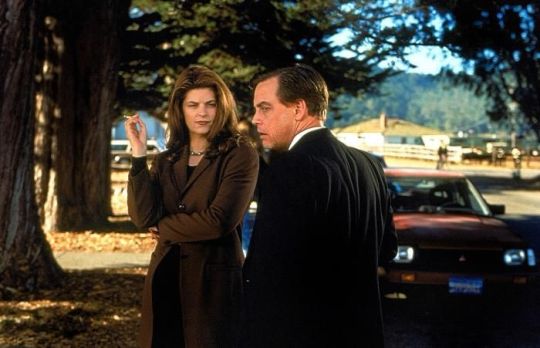
Kirstie Alley as Dr Susan Verner in Village of the Damned
And that's only the first 30! Stay tuned for the next installment!
8 notes
·
View notes
Text

Illustration for Richard S. Shaver's «The Princess and Her pig»
Rod Ruth (1912 – 1987)
6 notes
·
View notes
Text


More from “I Remember Lemuria”, Richard Shaver’s longest book in the Shaver Mystery; he was naturally attracted to the Variforms (human-animal hybrids that were coincidentally all beautiful women that spoke to him with a smirky condescending affection) and now he’s meeting an eighty-foot-tall psychic princess (for an “oral check”) and he’s worried that if he gets close enough to touch her (specifically her feet) he’ll lose his capacity for independent thought. (Don’t worry, his sparkly purple pony waifu understood how irresistible the giantess was, and along with the other women of their party asked her politely to release their boyfriends from her “sex aura”.)
Remember, this was written in 1948.
He’s been hitting so many horny fanfic tropes I swear any minute now he’s gonna invent omegaverse.
4 notes
·
View notes

